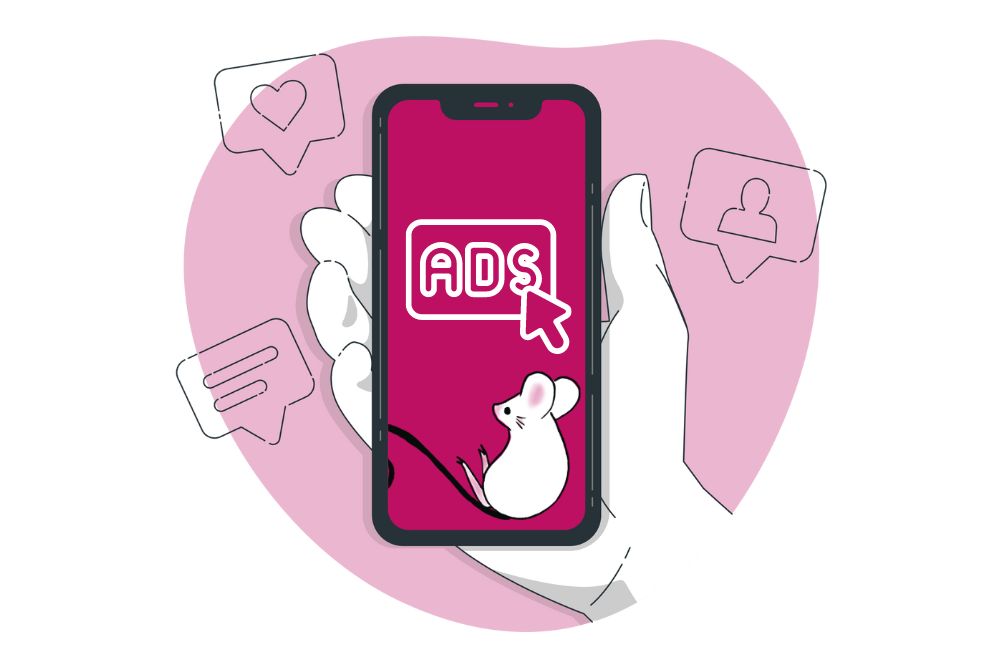Social media is an integral part of our daily lives, influencing how we connect, communicate, and consume information. For businesses, leveraging social media platforms for advertising is a strategic imperative. However, the success of social media advertising lies not only in creating compelling content but also in choosing the right ad placements.
In this blog, we will explore the key factors brands should consider when selecting social media ad placements to maximise their impact and return on investment. Get ready to learn how to choose your ad placements with Digital Squeak.
What Are Ad Placements?
Ad placement are a group of ad units that specify the areas on a Social Media Platform where advertisers can place their ads. Ad placement criteria include the size, type, and location of the ads.
Each Social Media platform offers a variety of ad placements options, allowing brands to tailor their strategies based on campaign goals, target audience, and the type of content they want to promote. Before you can decide which ad placements to choose, brands need to understand the unique features of each placement option.
Ad Placement Options

Here’s an overview of ad placement options on some popular social media platforms:
- News Feed ads appear directly in users’ main feed, seamlessly integrated with organic content. This placement supports various ad formats, including image, video, carousel, slideshow, and more.
- Stories are full-screen, vertical ads that appear in users’ Stories feed. Stories are ideal for visually engaging and immersive content.
- Right Column ads are the traditional sidebar ads visible on the right side of the desktop version. This placement works well for image or carousel ads with concise copy. Keep in mind that this is a desktop-only placement, and therefore shouldn’t be a priority placement for most brands in South Africa.
- Marketplace ads are integrated into the Marketplace section, reaching users browsing for products or services.
- In-Stream Video placements play video ads appearing during Facebook Watch videos. This placement is suited for longer video content and brand storytelling.
There’s no doubting the power of Instagram, and it can be extremely effective for some businesses. But let’s dive into the different placements that are possible on this social media platform.
- Feed allows various ad formats, similar to Facebook’s News Feed, and is ideal for visually compelling image and video ads.
- Stories are full-screen, vertical ads that appear between users’ Stories, offering an immersive, mobile-first advertising experience.
- Explore ads appear in the Explore section, targeting users discovering new content. This placement is suitable for expanding brand reach and introducing products.
- IGTV ads are In-Stream video ads within Instagram’s long-form video platform. These are great for brands looking to engage users with more extended content.
LinkedIn is a powerful platform, and while it can be considered expensive, there is no doubting LinkedIn’s effectiveness when it comes to digital marketing.
- Sponsored Content appears in users’ feeds, similar to Facebook’s News Feed, and is best suited for B2B marketing and professional networking.
- Sponsored InMail are messages sent directly to users’ LinkedIn inboxes. We recommend these for personalised outreach and lead generation.
- Display Ads are the traditional display ads visible on the right side of the desktop version, and are only really suitable for brand awareness campaigns.
X (Twitter)
Twitter, now known as X, is a social media platform that offers some really great opportunities for Social Media Marketing. Once you’ve determined if Twitter (X) is an effective solution for your business, here are the different ad placements you can choose from.
- Timeline ads appear in users’ timelines alongside organic tweets, and supports various formats like image, video, and carousel ads.
- Promoted Trends are sponsored hashtags that appear at the top of the Trending Topics list. This placement offers high visibility and engagement for time-sensitive campaigns.
- Promoted Moments are ads within curated collections of tweets around a specific event or theme.
TikTok
TikTok advertising can be extremely impactful when done correctly. Here’s how to choose your ad placements on TikTok.
- In-Feed Ads are native ads that appear in users’ For You feed as they scroll. This placement support a variety of content formats, including image, video, and carousel ads.
- Branded Hashtag Challenges allow brands to create and promote challenges using a branded hashtag, which encourages user-generated content and engagement.
- Branded Effects are sponsored visual effects that users can apply to their videos. These enhance brand visibility and engagement in a creative way.
- TopView ads are video ads that appear when users first open the app. This placement offers high visibility and is suitable for impactful brand introductions.
- Branded Content ads are used in collaboration with TikTok influencers for sponsored content. Only use this if you have found the right influencer for your brand and want to leverage an influencers’ reach and authenticity for brand promotion.
Snapchat
- Snap Ads are full-screen vertical video ads that appear between users’ Stories. This is an engaging format with interactive elements like swipe-up actions.
- Filters and Lenses are sponsored filters or augmented reality lenses for users to interact with. This placement is ideal for creative and interactive campaigns.
- Discover Ads are displayed within the Discover section, reaching users exploring curated content. This placement is suitable for brand partnerships and sponsored content.
- Promoted Pins are ads that appear in users’ Home Feeds and Search Results. This placement is ideal for showcasing products and driving traffic to a website.
- Promoted Video Pins are for video content promoted within the platform. This is most effective for storytelling and product demonstrations.
- Shopping Ads are product-focused ads that appear in the Shopping Tab and Search Results. We recommend this placement for e-commerce and product-centric campaigns.
Understanding Your Audience
The foundation of any successful advertising campaign is a deep understanding of your target audience. Brands need to identify the demographics, interests, behaviours, and preferences of their audience across different social media platforms. Each platform attracts a unique user base, so knowing where your audience spends the most time is crucial.
Demographics and User Behaviour
- Analyse the demographics of your followers on each platform.
- Understand user behaviour – what content do your followers engage with and how do they interact with your brand.
Platform-Specific Features
- Each platform offers distinct features. Instagram and TikTok are visually-driven, while X (Twitter) focuses on real-time updates. Tailor your ad content to align with these features.
Choosing the Right Platforms

Once you understand your audience, it’s time to choose the right platforms and how to choose your ad placements. Consider the following factors:
- Platform Relevance: Select platforms that align with your brand and where your target audience is most active.
- Ad Formats: Different platforms support various ad formats (e.g., images, videos, carousels). Choose the format that resonates best with your audience and campaign goals on that specific platform.
- Budget Allocation: Allocate your budget based on the platform’s advertising costs and your campaign objectives.
Understanding Ad Formats
The success of a campaign not only hinges on understanding your audience and choosing the right platforms, but also on strategically selecting the appropriate ad formats and placements. Here’s a breakdown on ad format options.
Image Ads
- Ideal for showcasing visually appealing products or lifestyle shots.
- Platforms like Instagram and Facebook News Feed are conducive to image-centric ads.
- Utilise high-quality, attention-grabbing visuals that encapsulate your brand message succinctly.
Video Ads
- Effective for storytelling and engaging a wide audience.
- Platforms like Facebook, Instagram, TikTok, and X (Twitter) support various video lengths.
- Craft compelling narratives and maintain a balance between brevity and conveying the essential message.
Carousel Ads
- Perfect for showcasing a series of products or highlighting different features.
- Facebook, Instagram, and LinkedIn are popular platforms for carousel ads.
- Ensure a logical sequence in your carousel to maintain coherence and captivate viewers.
Slideshow Ad
- A dynamic alternative for brands with limited video resources.
- Facebook supports slideshow ads, offering a cost-effective way to convey a narrative through a series of images.
Story Ads
- Tailored for a mobile-first experience, particularly on platforms like Instagram and Facebook.
- Leverage the immersive, full-screen format to create impactful and visually appealing short stories.
Augmented Reality (AR) Ads
- Emerging on platforms like Snapchat and Facebook, AR ads provide an interactive experience.
- Ideal for brands in the beauty, fashion, or tech industries, allowing users to virtually try products.
Aligning Ad Formats with Placements
Keep reading to understand which ad formats work best on the various placement options.
News Feed
- Best for image and video ads that seamlessly blend with users’ organic content.
- Utilise high-quality visuals to capture attention amidst a user’s regular feed.
Stories
- Tailor content to the vertical, full-screen format.
- Leverage the immersive nature of Stories with visually appealing and succinct ads.
Sidebar/Column Ads
- Ideal for image ads or carousel ads with a brief, eye-catching message.
- Consider the limited space and craft ads that are concise yet impactful.
Explore and Discovery Pages
- Optimal for carousel ads or image ads introducing new products or collections.
- Utilise visually appealing content to encourage users to explore further.
In-App Banners
- Suitable for announcements, promotions, or driving specific actions.
- Craft clear and concise messages that can be quickly absorbed.
Strategies for Determining Ad Placements Based on Ad Formats

- Goal Alignment: Align your ad format with your campaign goals. If the goal is brand awareness, visually striking formats like video or image ads in News Feeds may be effective.
- User Experience Consideration: Choose formats that enhance rather than disrupt the user experience on a specific platform. For example, opt for immersive Story ads on platforms where users actively engage with Stories.
- Content Adaptation: Tailor your ad content to suit the platform’s strengths. For instance, utilise Instagram’s visual focus for image-centric campaigns and Twitter’s real-time nature for timely and relevant messages.
- A/B Testing: Experiment with different ad formats across various placements. Conduct A/B testing to determine which combination yields the best results.
Optimising Ad Placements
With the platforms selected, it’s crucial to optimise ad placements for maximum effectiveness.
- Native Advertising: Create ads that seamlessly blend with the platform’s user experience for a more natural and non-intrusive feel.
- Placement Testing: Conduct A/B testing to determine the most effective ad placements. Test different positions on a page, such as news feeds, stories, or sidebars.
- Timing and Frequency: Consider the timing of your ads and how frequently they appear to avoid audience fatigue.
Monitoring and Analysing Performance
Continuous monitoring and analysis are vital for optimising social media ad placements.
- Analytics Tools: Use platform-specific analytics tools to track key performance metrics such as engagement, click-through rates, and conversions. It’s also helpful to use third-party analytics tools to help you be able to easily evaluate performance across multiple platforms simultaneously.
- Performance Metrics: Evaluate the success of your ad placements based on predefined KPIs. Adjust your strategy based on the data.
Final Thoughts on Optimized Ad Placement
The selection of social media ad placements is a nuanced process that requires a deep understanding of your audience, careful platform selection, and ongoing optimisation.
By tailoring your approach to the unique features of each platform and leveraging advanced targeting options, you can create a more personalised and effective advertising strategy.
Regular monitoring and analysis ensure that your brand stays adaptable in the ever-evolving landscape of social media advertising. By following these guidelines, brands can enhance their social media presence, engage their audience effectively, and achieve measurable results.
Reach out to Digital Squeak so we can create and walk through a social media advertising strategy that would work for your company – pippa@digitalsqueak.co.za

Pippa is Digital Squeak’s Founder. In her hunt to balance her passion for digital marketing and her responsibilities as a single mom, she decided that the best solution was to start an agency that not only delivered exceptional service to clients, but provided the team with the freedom they needed to live their lives to the fullest.





